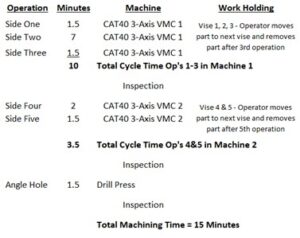
Not every company has accountants that track the cost of intermediate stages within the production process. These processes include items such as materials, labor to move product through partial completion stages, and overhead costs. This fun measure is called Work-In-Progress (WIP).
WIP expenses are very real and are sometimes best measured by a less technical term known as the “Chaos Factor”. The “Chaos Factor” is the pain felt by constant scheduling, expediting, rerouting, and adjusting deliveries.
Every time that pesky Chaos Factor makes an appearance, it requires someone to write a check and pay for inefficiencies. Sometimes supply chain issues cause the Chaos Factor, but many times it is a result of capability or even a deeply held, built-in culture.
For example, a customer asks Machine Shop A to quote an order for 200 parts with ship dates of 50 parts per month that require five sides of the part to be machined.
Machine Shop A’s in-house capabilities requires that to successfully machine these parts, it will require them to process the parts across two (2) CAT 40 taper vertical machining centers, 5 vices, and one drill press for the angled hole. Machine Shop A anticipates that it will take about 30 hours to complete the parts, however knowing the operator can’t always be at all the machines when each cycle finishes, the company quotes the job at 40 hours to complete the parts.
The decision to purchase all the material and run all 200 parts at once is made to reduce redundant set-up and programming costs. Therefore, Machine Shop A will inventory the balance of the parts and ship each batch of 50 on the scheduled release dates. Money in the bank or is it?

Assumptions:
- Machines are close enough together for one operator to run all three machines
- Operator has time to inspect
- Machines are all open at the same time
In the real world, two machines are rarely open at the same time much less next to each other which would allow one operator to run these parts in an efficient manner. There would be a need for multiple operations / fixtures, creating opportunity for error, and requiring inventory to compensate for the lack of agility that a multi-machine process creates. This is the Chaos Factor.
Customer then calls Machine Shop B who just purchased a new Mazak Variaxis C-600 5-axis machining center. The part goes into the machine, with one work holding, is machined and removed complete with all accuracies achieved because there is no tolerance stacking associated with multiple work holdings. Inspection costs and scrap are reduced, and because Machine Shop B purchased a robot that can be programmed in 10 minutes to load and unload the part, they receive consistent unmanned operation. Moreover, they can run the parts in 12.5 hours, mostly unattended, and get 50 parts to ship complete without the inefficiencies of multiple operations and batch machining.
Using Mazak’s 5-axis Variaxis solution, Machine Shop B has eliminated the “Chaos Factor” and costs associated with WIP.
DONE IN ONE
- Increases capacity, flexibility, productivity and profitability.
- Improves machining accuracy and overall part quality.
- Streamlines production and boosts output with fewer machines and less increases in workforce.
- Maximizes use of floor space
- Enhances overall management and enables production of parts on demand.
- Reduces part costs via fewer fixtures and less tooling.
- Keeps manufacturers competitive.

